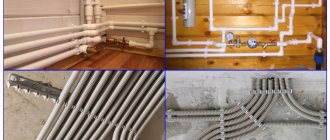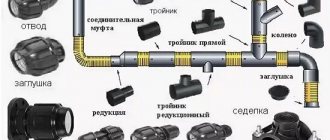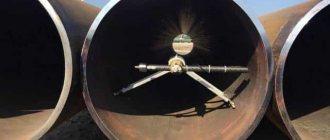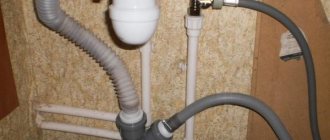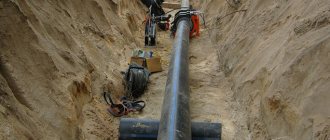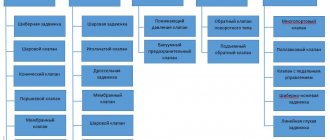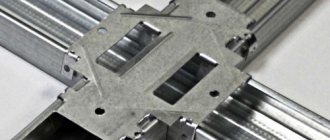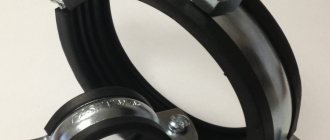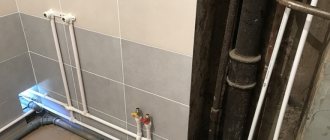Plastic pipes are used everywhere in everyday life: for heating installations, sewerage installations, and water supply installations. They have many advantages, and one of them is a relatively simple fastening that you can do yourself. Well, in order to assemble a system taking into account all the angles, turns and branches, a variety of connecting elements are required.
Pipe connection elements
Connection Features
Steel and cast iron pipes are fastened in 2 ways: by cutting, which is only possible with a relatively small diameter - 20 mm, for example, and by welding. Plastic products are fastened by soldering or using special connecting elements - fittings.
Moreover, the corner of the connection made of plastic pipes does not in any way exclude welding. In this case, it is not the ends of the pipes that are subjected to melting, but the fitting itself, into which the water conduit is then inserted.
Connection corner
The use of fittings during installation greatly facilitates and speeds up installation. In addition, the variety of the latter makes it possible to assemble systems that are very complex in configuration, which is one of the advantages of using plastic products.
Types of fasteners
The question of which bracket is better certainly arises at a certain stage of construction or repair. To answer it, you need to have a clear understanding of the features of the work to be done and the parameters of the pipes.
In the case of a large diameter of the latter, or their significant weight, it is recommended to use double fasteners. For small pipes, single elements are quite suitable.
The pipeline is installed, as a rule, using metal holders made of durable steel. In this case, it is possible to attach directly to the surface. The choice of steel holders is directly determined by the design features and the degree of future load.
There are two ways to fix the pipeline - rigidly or loosely. Rigid fastening is carried out in places of increased load, where there is a risk of violating the integrity of the structure.
Loose fastening is needed where there is an effect of thermal expansion of the material. Brackets for heating pipes allow them to move freely within the fixture during expansion, but securely fix the entire system to the wall.
Brackets can be made of metal or plastic depending on the purpose of use. At the same time, they are divided into solid (one-piece) and composite (detachable).
Fixation of heavy metal pipelines is carried out using holders with a pin screwed into a certain surface near which the pipeline itself is located.
There are models of pipe brackets with a rubber seal to avoid mechanical damage when clamping. The diameters of the fasteners are varied and fit almost any pipe. Size range – from 14 mm to 540 mm.
Types of plastic pipe corners
It is worth noting right away that all connecting elements must be made of material corresponding to the pipes, and have the same parameters - wall thickness, diameter, and, in addition, correspond to the tasks. Manufacturers' catalogs indicate all the necessary characteristics.
Types of corners and fittings of plastic pipes
Distance between fasteners
Polypropylene pipes must be attached to the wall at a certain pitch, which depends on their diameter and operating temperature.
Heating the air in the room and the coolant in the system inevitably leads to thermal expansion, which cannot be completely eliminated even when using reinforced pipes. The heating system can be easily installed using plastic pipe brackets.
Moreover, the distance between the fastening elements must correspond to a certain standard, developed on the basis of many years of operational experience. Using the example of a PN 20 polypropylene pipe, it is easy to see the differences. With a pipe diameter of 25 mm and a coolant temperature in the system of 20°C, the fastening pitch should be no more than 1 m.
When the coolant temperature rises to 80°C, the distance should no longer exceed 85 cm. More detailed information can be easily seen in the corresponding tables.
A competent approach to the selection of brackets and compliance with all installation technology will guarantee the strength and reliability of fixation of the pipeline system.
Before you go shopping or order fasteners in an online store, you should carefully review the photos of pipe brackets. Thanks to this, you can easily choose the appropriate option from the entire variety of assortments.
Features of the material
The main difference between a product for heating and plumbing is the material. This category includes polypropylene, polyvinyl chloride, and metal-plastic products made from low-density polyethylene.
Pipes and angles
However, their qualities are completely different.
- Polypropylene or polyvinyl chloride is a monolithic product. Since the strength of the material is not that great, a pipeline of this kind has rather thick walls. For example, polypropylene pipes have a diameter of 20 mm, while the most popular diameter for water pipes is 16 mm. The photo shows a connecting plastic corner for a 20 mm pipe.
- Metal-plastic pipes include a layer of aluminum foil. This option is higher in strength, which makes it possible to produce products with a diameter of less than 20 mm. However, the soldering of such pipes is carried out according to a different scheme than the welding of ordinary plastic ones. Soldering involves mandatory stripping of the aluminum layer so that only the polymer components of the pipe are welded.
- Another variety related to materials is corners designed for attaching plastic pipes to metal ones. When connecting water supply, sewerage and plumbing, this situation occurs all the time. In this case, the fitting includes a standard socket for a polypropylene fragment, for example, and a threaded connection for a metal pipe on the other side.
Materials for work
What angles for heating pipes and pipelines of other systems are available for sale?
1) Angles for metal pipes
- Angle with thread for pipes
Since the beginning of the 20th century, these connecting elements have been used in the assembly of water supply and heating systems. They continue to be used to this day.
Specialists who dismantled heating systems in Stalinist high-rise buildings, where cast iron corners were used to assemble assemblies from galvanized pipes, were surprised by the fact that even after half a century of operation, the threaded connection and the connecting elements themselves were in perfect condition. This suggests that, despite the current unpopularity of steel fittings and pipes (they are being forced out of the market by polypropylene products), systems assembled on their basis are very reliable and durable.
What types of connecting angles for metal pipes are there? As a rule, these are fittings with internal, external or combined threads (both types at different ends of the part). There are also elements with transitional diameters for mounting two pipes of different sections.
The corner with a threaded connection is made of the following materials:
- Cast iron
. Perhaps the most wear-resistant material, not afraid of long-term use. It is characterized by rather thick walls, compensating for the fragility of the material. Such fittings can be easily unscrewed from a steel pipe and do not stick to it even during long-term use of several decades.
- Brass
in its pure form and chrome elements. These fittings are characterized by thinner walls, which reduce the strength of the connecting unit. For this reason, when installing brass parts, it is not recommended to apply excessive force to them.
- Black steel
. The two main negative properties of this material are susceptibility to corrosion and thread sticking. The positive side is a very good level of durability. Steel fittings are successfully used in high pressure water systems.
- Stainless steel.
The same high-strength connecting elements, which do not have the negative properties of products made of black steel. The price of these fittings is very high.
- Silumin.
Cheap Chinese products made from powdered metal. They are characterized by extremely low cost and almost complete lack of strength. Avoid using them, as most of these fittings become unusable already at the installation stage.
It is also worth noting that in addition to the listed materials for the manufacture of fittings, there are also copper pipes and corners for them made of the same metal. However, the price of copper pipes and angles is very high. Also, in addition to metal pipes with a round profile, there are products with a cross-section of a different configuration. The angle for profile pipes is used in the same way as connections and other fittings in the case of structures with a standard round cross-section.
Read material on the topic: Engineering plumbing wholesale: range and prices
Features of using angles for metal pipes with threaded connections:
- The process of cutting threads on metal pipes for these fittings is quite complicated. In addition, the length of the pipes must be selected very carefully, and the number of threads must be accurately taken into account. A “pull” connection is unacceptable, and with a high degree of probability the corner will be damaged during such installation.
- Threaded connections of plumbing and heating systems require additional sealing. A special sealant is screwed onto the threads before final installation. Winding is carried out along the thread. This sealing can be done using sanitary flax with paint, or using a polymer sealing thread.
Please note that FUM tape is not the best sealant for threaded joints. If, for example, you need to adjust the valve, placing it in a convenient position, and at the same time you allow the slightest reverse movement along the thread, then the connection is guaranteed to lose its tightness.
- Compression fittings
Compression angles for metal pipes are used less often than classic threaded angles, but they have their own specific niche of application:
- Problematic access to the pipe does not allow threading on it. It is rarely justified to destroy a section of a wall or ceiling in order to create one threaded connection.
- The pipes used are thin-walled, and threading them may render them unsuitable for further use in a pressurized system.
- The pipe section has undergone significant corrosion and cannot be replaced. In this case, the only solution is a compression fitting. If you try to create a threaded connection on a rusty pipe, it will most likely collapse.
Let's try to understand how such fittings are designed. The brass or plastic body of the element is equipped with a silicone or rubber o-ring inside. A steel pipe is inserted into the corner, clamped with a fixing nut, while the sealing ring inside the fitting tightly grips the surface of the pipe. It is eventually secured mechanically, creating a reliable hermetic connection.
Features of using compression corners:
- A compression assembly, unlike a threaded one, can suffer from an accidental blow to the opposite direction of the connection or from a strong jerk.
- Before installation, the surface of the pipe must be thoroughly cleaned of rust, paint residues, and uneven surfaces must be removed, otherwise the tightness of the assembly cannot be ensured.
2) Angles for polypropylene pipes
The internal diameter of the corners for polypropylene products exceeds the size of the pipe itself. Installation of such parts of the structure occurs by strongly heating two elements with a special soldering iron and then soldering them to each other. After 15 seconds, after the polypropylene has cooled, a reliable monolithic connection is obtained.
Angles for plastic pipes are molded with the smoothest inner surface possible to ensure a reliable solder joint. There is nothing complicated about them, since they are a simple corner polymer element.
However, there are also specialized corner fittings:
- Tees and crosses with leads made at different angles are used to connect several backbone networks.
- Angles for PVC pipes can be made with several rotation angles: 90, 45 and 30 degrees.
- The diameter of the angle outlet can be equal to the diameter of the supply pipe. Sometimes it is necessary to connect a pipe using a coupling or to turn the main line at another angle.
- Connecting elements are manufactured with different internal diameters to provide a convenient transition from one size pipe to another.
- The angle outlet can be made of brass for a threaded connection. This fitting is necessary when installing a steel riser with ready-made polypropylene wiring.
- Angle combined with a throttle or valve. The throttle can be supplemented with an American fitting - a special fitting designed to connect the angle with an aluminum radiator.
Features of polypropylene corners:
- A connection made according to all the rules is a monolith and is no different from a solid pipe. This allows such a structure to be laid in a screed or groove without fear that the joined area will subsequently lose its tightness.
- Unreinforced polypropylene pipes have a very high coefficient of expansion, so when you hide the wiring in a groove, keep in mind that there should be at least 5–10 mm of free space from the outer edge of the fitting to the stop in the groove.
It is important to know that when welding polypropylene pipes reinforced with aluminum foil, do not forget to strip the end of the pipe of metal. The remaining particles can negatively affect the tightness of the connection.
To perform stripping, special tools are used, equipped with several cutting edges inside the nozzle: a trimmer or a shaver. The choice depends on how the reinforcement layer is positioned.
Read material on the topic: Wholesale sale of polypropylene pipes at competitive prices
3) Corners for cross-linked polyethylene
The material of the pipes is cross-linked polyethylene, which differs from the usual one and has the following properties:
- Significant mechanical strength;
- Increased melting point (compared to conventional polyethylene);
- High level of flexibility and molecular memory.
It is the molecular memory of this material that helps to produce a reliable, hermetically sealed connection of pipes using fittings. A brass or plastic corner for mounting a HDPE pipe is a regular fitting and a plastic ring.
Instructions for connecting a pipe with a fitting:
- The plastic ring is first placed on the pipe and moved away from its edge.
- An expander must be inserted into the inner diameter of the pipe - a tool specifically designed for making connections to HDPE pipes. The expander plunges into the pipe in several movements, stretching its end.
- The stretched end of the pipe is put on the fitting. The molecular memory of the material forces the pipe to take its previous position, due to which the fitting is tightly pressed against the edges of the pipe after some time.
- A retaining ring additionally secures the end of the pipe.
Angles for cross-linked polyethylene (fitting with a locking ring) come in several diameters and are made in various combinations similar to the compression fittings described above.
Features of corners for mounting cross-linked polyethylene pipes:
- The resulting connection is very strong and practically inseparable. If it becomes necessary to disconnect the pipe from the fitting, then a small section of it is simply cut off, and then, by displacing the retaining ring, the polyethylene is gradually cut off from the fitting.
- The pipes are sold in coils up to 500 m long. They are not only durable, but also very flexible, which is why they are often used for installing heated floors and for collecting water distribution.
- The disadvantage of these pipes is not their properties, but the price of the expander used to make the connections. The cost of such a tool starts from 15 thousand rubles. If necessary, it is easier to rent a device.
3) Angle for metal-plastic pipes
- Compression corners
A simple and reliable corner fitting is used in places where you need to turn the main pipe or change its direction. The main parts of such a connection are a fitting, rubber O-rings, a union nut and a split ring. This pipe corner can be made of regular or chrome-plated brass.
To connect the corner to the pipe, you need:
- Straighten the section of pipe required for installation.
- Treat the inner surface of the pipe by chamfering.
- Install the union nut and split ring
- Insert the fitting into the end of the pipe all the way. Try to do this so that rubber sealing rings are placed between the pipe and the fitting.
- Tighten the nut on the fitting until it stops.
- It is necessary to tighten moderately, avoiding excessive force. As the nut is tightened, the split ring will gradually compress and ultimately form a reliable sealed connection.
At this stage, you can switch to other pipe diameters, threaded connections, etc.
You will need a simple basic set of tools to install the pipeline using these fittings. This scheme should not be used when assembling a hot water supply and heating system. As it cools and heats up again, the connection loses its tightness due to the displacement of the rubber sealing rings in it. However, the leak is eliminated by re-tightening the union nut.
- Press fittings
Connections made using press fittings do not have the negative characteristics inherent in compression elements. The split ring and union nut are not used here, and instead the unit is secured by a wide retaining ring. This type of fitting is used for installation of heating and hot water supply without restrictions, but its implementation requires a special tool.
4) Angle for sewer pipe
The fitting for connecting sewer lines is a pipe angle of 90, 45 degrees with an extension at one of the ends.
To ensure the tightness of cast iron units, they are minted, then the remaining gap between the expansion and the pipe is clogged with oiled cable and filled with sulfur or cement.
Docking made in this way does not tolerate mutual displacement of the elements, since the tightness is easily broken. In addition, to perform a connection using the embossing method, even a specialist needs to spend 20–30 minutes, and carrying out this procedure from the side of the wall is an even more difficult task.
But cast iron parts are becoming a thing of the past, and they are being replaced by PVC fittings and sewer pipes. For installation of structures, simple angles for plastic pipes are used. Their price is very low, working with them is a pleasure. The connection occurs by inserting the pipe into the fitting with some force. The rubber O-ring, which is located at the wide end of the angle, ensures a reliable seal. Installation is very fast. Once the pipe and fitting are connected, you can proceed to the next unit.
During operation, the rubber ring may harden and the seal of the joint will be compromised. To avoid this unpleasant incident, when assembling the pipeline, the parts are additionally coated with silicone-based sealant.
PVC fittings for sewerage are not much different in shape and installation options from those described earlier. The same tees, adapters, combinations, etc. are used, and the rubber sealing ring ensures reliable tightness of the connection.
Read material on the topic: Sealing materials for plumbing: types and application features
5) Swivel corner fittings
This fitting requires separate consideration. Let's figure out what it is.
This is a complex connecting element used in high-pressure systems where mobility of the installed pipeline components is important (or cannot be avoided).
Examples of such movable structures are given below:
- Drives powered by hydraulics. A simple example is a hydraulic cylinder, which is used to raise the blade of a motor grader and connect it to high-pressure hoses.
- A fire hose that unwinds without kinks in any direction from the point of attachment on the shield.
- Familiar refueling nozzles at gas stations.
- The hoses in the car wash into which water is supplied are also movably connected.
The method by which the moving assembly is sealed is not new. In its simplest form, it is an oil seal with oil or graphite packing. In this way, to this day, the shafts of the booster pump are sealed during cold water supply.
However, the seals wear out quickly, and this is a significant problem. Pumps, plug and screw valves, as well as other devices require periodic packing of the connection.
Modern swivel fittings are made from much more wear-resistant materials. A simple example of using such a unit under low load conditions is a regular ball valve. Sealing of the moving element in it is ensured through the use of a seal made of wear-resistant plastic with a low coefficient of friction.
Fittings used in high-pressure networks have a rolling bearing, due to which the sealing plastic wears out much less.
Types of corners
Elbow is one of the most common types of fittings. Using this element, installation is carried out at an angle, and in a variety of ways. Of course, polypropylene pipes can be bent, but in this case the thickness and diameter of the product change, and the throughput capacity decreases.
Angles for soldering plastic pipes solve this problem. The following varieties are distinguished:
- Actually, the corner is a knee at an angle of 30, 45, 90 degrees. Allows you to connect 2 pipes at the required angle. In the catalog of large stores you can always find products of the required diameter and wall thickness;
- tee angles for plastic pipes - used when branching a pipeline. The tee can include bends at different angles - 30, 45 and 90 degrees. In addition, tees are also designed for fastening metal and plastic pipes;
Why do you need a pipe corner?
Let's try to understand the specifics of using pipe angles. Why use such a connection when you can bend the pipe yourself at the required angle? There are the following reasons for this:
- During installation, it is sometimes necessary to rotate the pipe with a minimum radius.
Perhaps only a corrugated stainless pipe is suitable for making a bend with a radius that is equal to its diameter.
- The external aesthetics of the connection is also important.
It is very difficult to bend a pipe without using a special tool so that it also looks beautiful. On the contrary, two straight segments joined using a corner will look much neater.
- By bending the pipe (without using angles), you reduce its internal diameter.
Accordingly, its throughput decreases.
Often, instead of a factory angle for a steel pipe, a so-called bend is used during installation. This is a small piece of pipe bent on a special machine at a certain angle. It is installed at the junction of two pipes and welded to them.
In addition to the right angle design, fittings are also manufactured with other bending values: 15, 30, 45, 60 degrees. The structure assembled using such elements has increased throughput. When using straight pipe fittings, turbulence increases at the installation sites and silt deposits accumulate.
We figured out the main purpose of angles for connecting pipes, and considered the possibility of using elements with different degrees of bending. Now we will find out what types of fittings are used in the installation of various engineering systems, and in what situations it is preferable to use one or another corner element.
Features of corner fittings
The simplest corner of a classic look and material is a cast iron part with an internal thread with a rotation angle of 900. These are the fittings that builders used in the recent past. Today, when demands have changed, plastic pipes and new technologies for installing communications have appeared, corner fittings have become more complex. With their help, they now connect not only water supply, heating or gas pipelines, but also pneumatic systems operating at high pressure.
Features of using corner fittings:
- a section of a pipeline connected by a fitting is not inferior in strength and durability to a solid pipe;
- the corner fitting helps maintain the throughput of the line when turning;
- the corner allows you to make the pipeline collapsible.
It would seem that the butt joint cannot be as reliable as a solid pipe, and therefore, to create a perfect pipeline, it is better to bend the pipe in the desired direction using a pipe bender - this will cost less, and there will be no potential leakage.
However, in practice, using a pipe bender when installing communications in a building can be difficult, and in some cases impossible. The fact is that a manual (mobile) pipe bender can only be used on small-diameter pipes, and it is impossible to install whole pipes in a limited space. A bent pipe is used when installing industrial highways and when laying external communications.
We recommend that you read: Fittings for connecting a heated towel rail
To increase the reliability of the fitting connection, angles with permanent fixation are used - welded or press-fit. The threaded connection is reinforced with sealant.
The second point between choosing a bent pipe or using an elbow fitting is maintaining the flow capacity of the line when turning. A pipe, even bent on a professional pipe bender, becomes deformed and flattened at the break. Its internal lumen narrows, and its throughput decreases. The use of an angle fitting helps avoid this issue.
Note! When installing household communications, corner fittings or shut-off elements with several outlets are used to change the direction of the pipe.

